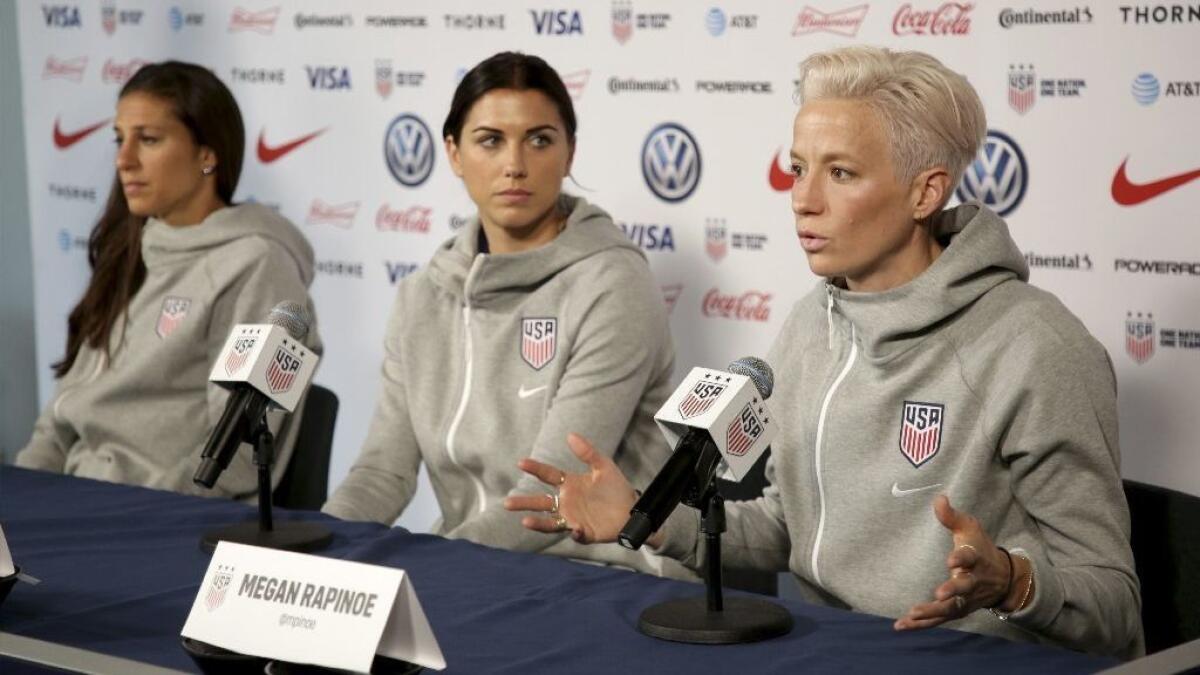U.S. Soccer and USWNT players agree to mediation over pay dispute

Reporting from REIMS, France — U.S. Soccer and the 28 women’s national team players who have sued the federation over pay inequity and other workplace issues have agreed to mediation, a sign their dispute could be headed toward a resolution.
Mediation is expected to begin shortly after the Women’s World Cup ends July 7. The agreement was first reported by the Wall Street Journal and confirmed by representatives for both sides.
The players sued the federation in Los Angeles federal court in March, alleging ongoing “institutionalized gender discrimination” in pay, travel and other working conditions despite the fact they have the same job responsibilities as men’s national team players.
U.S. Soccer, which rejected the claims, pointed to the collective bargaining agreement the women’s national players signed in 2017, one that is substantially different from the one the federation has with the men’s team.
The women’s players, all of whom play in the NWSL, receive club salary and benefits paid by U.S. Soccer, which helps subsidize the professional league, in addition to bonuses for playing with the national team. The men’s players, whose base salary and benefits are paid by their pro club teams, receive U.S. Soccer bonuses based on roster selection and performances in games and tournaments.
But the women’s case might have gotten a boost from a report in the Wall Street Journal last week. Based on U.S. Soccer’s audited financial statements, the newspaper said the women generated game-related revenues of $50.8 million in the three years following their 2015 Women’s World Cup win, nearly $1 million more than the men made.
In 2011, the men earned nearly 20 times what the women did from game-related revenue, the Journal report showed.
The women’s team has been more successful on the field, not only winning the last World Cup but also winning their first three games of the current one, outscoring the competition 18-0 to advance to Monday’s round-of-16 game with Spain.
The men failed to qualify for their World Cup last summer and have advanced past the second round just once.
Those figures do not include broadcast and sponsorship fees, which are sold as a package for both the men’s and women’s teams, or money received from outside sources such as FIFA.
A U.S. Soccer spokesman said lawyers for the players reached out to the federation about mediation shortly after the Women’s World Cup kicked off two weeks ago. The federation accepted their proposal last week but said it wanted to keep the agreement private until after the tournament concluded.
“While we welcome the opportunity to mediate,” the federation said in a written statement, “we are disappointed the Plantiffs’ counsel felt it necessary to share this news publicly during the Women’s World Cup and create any possible distraction from the team’s focus on the tournament.”
Defender Kelley O’Hara, one of the 28 players whose name is on the complaint, said that wasn’t an issue.
“We’re here to win a World Cup,” she said Saturday. “We obviously have things going on back home that we’ll deal with when we get back there. This team has always been very good at focusing on the task at hand.
“This is just another example.”
Sign up for our weekly soccer newsletter »
While agreeing to mediation is a positive sign, it is no guarantee a settlement will be reached or a trial will be avoided. The process simply means that both sides agree to present their arguments, in private, to a mediator who, unlike a judge or an arbitrator, has no power to issue a legally binding decision.
Instead the mediator simply recommends a course of action, but if one or both sides reject that, the litigation could resume.
Complicating things for the federation is the fact that agreeing to the players’ demand would require altering the collective bargaining agreement to which their union has already agreed. That would set a dangerous precedent both the men’s and women’s teams could exploit going forward.
“The women are paid under a different structure than the men, which they preferred and specifically negotiated for,” the federation said in its statement. “But that doesn’t mean they are compensated less by U.S. Soccer.”
In their lawsuit, the players say that between March 2013 and December 2016, when the previous collective bargaining agreement expired, women’s national team players could have earned no more than $99,000, or $4,950 per game, for playing and winning a series of 20 games in one year, 62% less than a men’s national team member would have made from an equal series of games.
[email protected] | Twitter: @kbaxter11







